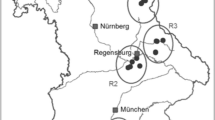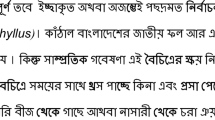Abstract
American ginseng, Panax quinquefolius L., is one of the most heavily traded medicinal plants in North America. The effect of harvest on genetic diversity in ginseng was measured with a single generation culling simulation program. Culling scenarios included random harvest at varying levels, legal limit random harvest and legal limit mature plant harvest. The legal limit was determined by the proportion of legally harvestable plants per population (% mature plants per population). Random harvest at varying levels resulted in significant loss of genetic diversity, especially allelic richness. Relative to initial levels, average within-population genetic diversity (H e) was significantly lower when plants were culled randomly at the legal limit (Mann–Whitney U = 430, p < 0.001) or when only mature plants were culled (Mann–Whitney U = 394, p < 0.01). Within-population genetic diversity was significantly higher with legal limit mature plant harvest (H e = 0.068) than when plants were culled randomly at the legal limit (H e = 0.064; U = 202, p < 0.01). Based on these simulations of harvest over one generation, we recommend that harvesting fewer than the proportion of mature plants could reduce the negative genetic effects of harvest on ginseng populations.
Similar content being viewed by others
References
Anderson R.C., Fralish J.S., Armstrong J.E. and Benjamin P.K. 1993. The ecology and biology of Panax quinquefolium L. (Araliaceae) in Illinois. American Midland Naturalist 129: 357–372.
Allendorf F.W. 1986. Genetic drift and the loss of alleles versus heterozygosity. Zoo Biology 5: 181–190.
Allison G.W., Lubchenco J. and Carr M.H. 1998. Marine Reserves are necessary but not sufficient for marine conservation. Ecological Applications 8(1): 579–592 (Suppl. S).
Briggs D. and Walters S.M. 1997. Plant Variation and Evolution. 3rd edn. Cambridge University Press, New York.
Charron D. and Gagnon D. 1991. The demography of northern populations of Panax quinquefolium (American ginseng). Journal of Ecology 79: 431–445.
Cruse-Sanders J.M. and Hamrick J.L. 2004. Genetic diversity in harvested and protected populations of wild American ginseng, Panax quinquefolius L. (Araliaceae). American Journal of Botany 91: 540–548.
Gagnon D. 1999. An analysis of the sustainability of American ginseng harvesting from the wild: the problem and possible solutions. Report to the Office of Scientific Authority of the US Fish and Wildlife Service.
Gilpen M.E. and Soulé M.E. 1986. Minimum viable populations: processes of species extinction. In: Soulé M.E. (ed.) Conservation Biology: The Science of Scarcity and Diversity. Sinauer, Sunderland, Massachusetts, pp. 19–34.
Heywood V.H. 1993. Flowering Plants of the World. Oxford University Press, New York.
Lewis W.H. 1988. Regrowth of a decimated population of Panax quinquefolium in a Missouri climax forest. Rhodora 90: 1–5.
Lewis W.H. and Zenger V.E. 1982. Population dynamics of the American ginseng Panax quinquefolium (Arailiaceae). American Journal of Botany 69: 1483–1490.
Ludwig D. and Walters C.J. 1985. Are age structured models appropriate for catch-effort data? Canadian Journal of Fishery and Aquatic Science 42: 1066–1072.
Luikart G. and Cornuet J.M. 1998. Empirical evaluation of a test for identifying recently bottlenecked populations from allele frequency data. Conservation Biology 12: 228–237.
Mangel M. 1998. Evolutionary games and population dynamics. Nature 395: 32.
Milner-Gulland E.J., Shea K., Possingham H., Coulson T. and Wilcox C. 2001. Competing harvesting strategies in a simulated population under uncertainty. Animal Conservation 4: 157–167.
Menges E.S. 1991. The application of minimum viable population theory to plants. In: Faulk D.A. and Holsinger K.E. (eds) Genetics and Conservation of Rare Plants. Oxford University Press, New York, pp. 45–61.
Nei M., Maruyama T. and Chakraborty R. 1975. The bottleneck effect and genetic variability in populations. Evolution 29: 1–10.
Nantel P., Gagnon D. and Nault A. 1996. Population viability analysis of American ginseng and wild leek harvested in stochastic environments. Conservation Biology 10: 608–621.
Primack R.B. 1993. Essentials of Conservation Biology. Sinauer, Sunderland, Massachusetts.
Robbins C.S. 1998. American Ginseng: The Root of North America’s Medicinal Herb Trade. TRAFFIC North America Report #B347.
Robbins C.S. 2000. Comparative analysis of management regimes and medicinal plant trade monitoring mechanisms for American ginseng and goldenseal. Conservation Biology 14: 1422–1434.
Roberts C.M. 1997. Ecological advice for the global fisheries crisis. Trends in Ecology and Evolution 12: 35–38.
Rock J., Hornbeck H., Teitjen J. and Choberka E. 1999. Habitat modeling and protection of American ginseng (Panax quinquefolius L.) in Great Smoky Mountains National Park. Report for the U.S. National Park Service, Gatlinburg, Tennessee.
SAS Institute, Inc. 2000. SAS/STAT User’s Guide, Version 8. Vol. 1–3. SAS, Cary, North Carolina.
Schoen D.J. and Brown A.H.D. 1991. Intraspecific variation in population gene diversity and effective population size correlates with the mating system in plants. Proceedings of the National Academy of Science USA 88: 4494–4497.
Shaffer M.L. 1981. Minimum population sizes for species conservation. Bioscience 31: 131–134.
Sheldon J.W., Balick M.J. and Laird S. 1997. Medicinal Plants: Can Utilization and Conservation Coexist? New York Botanical Garden, Bronx, New York.
Vance N.C. 2002. Ecological considerations in sustainable use of wild plants. In: Jones E.T., McLain R.J. and Weigand J. (eds) Nontimber Forest Products in the United States. University Press of Kansas, Lawrence, Kansas, pp. 151–162.
Weir B.S. and Cockerham C.C. 1984. Estimating F-statistics for the analysis of population structure. Evolution 38: 1358–1370.
Wen J. and Zimmer E.A. 1996. Phylogeny and biogeography of Panax L. (the ginseng genus, Arailiaceae): inferences from ITS sequences of nuclear ribosomal DNA. Molecular Phylogenetics and Evolution 6: 167–177.
Wendel J.F. and Parks C.R. 1982. Genetic control of isozyme variation in Camellia japonica L. Journal of Heredity 73: 197–204.
Author information
Authors and Affiliations
Corresponding author
Rights and permissions
About this article
Cite this article
Cruse-Sanders, J.M., Hamrick, J. & Ahumada, J.A. Consequences of harvesting for genetic diversity in American ginseng (Panax quinquefolius L.): a simulation study. Biodivers Conserv 14, 493–504 (2005). https://doi.org/10.1007/s10531-004-7308-7
Issue Date:
DOI: https://doi.org/10.1007/s10531-004-7308-7




